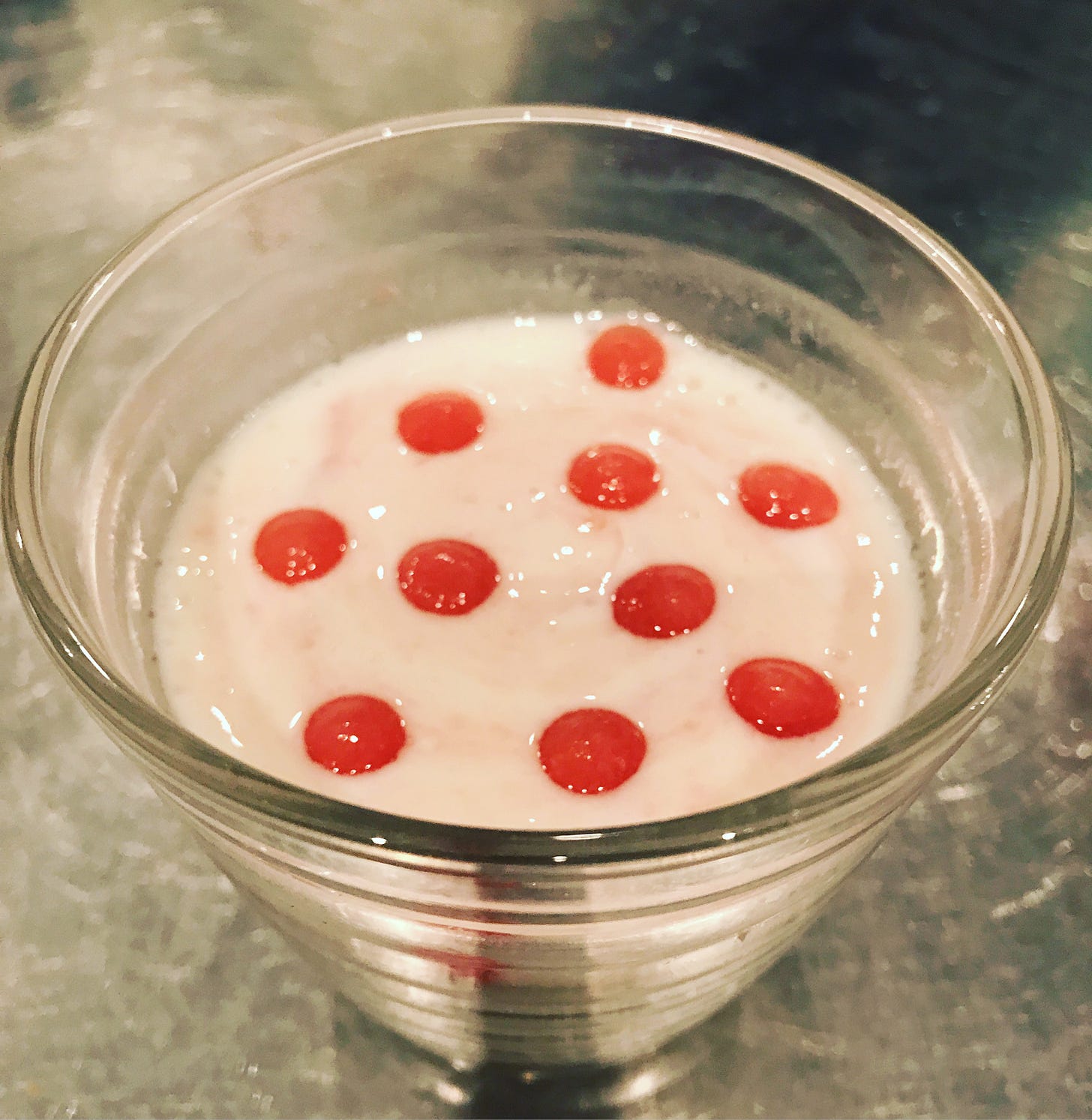One of the Ks every day….
And a quick and delicious recipe to help you achieve this worthy goal.
NEW WORKSHOP MILK KEFIR ONLINE 20th JULY CLICK HERE!
Good morning/afternoon/evening dear reader!
Given the disparate origins of our most popular fermented foods, it’s quite a coincidence that most of them seem to begin with a K: kefir, kimchi, kombucha, ‘kraut, kvass, koji. And luckily, therefore, this gives rise to the following excellent maxim, which any proponent of fermented foods will stand by including me, obviously.
What’s the evidence?
The health benefits of fermented foods have been intensively investigated, and the balance of evidence shows that yes, they really are good for you. They are sometimes called “Functional Foods” - a phrase coined in the 1990s to describe foods that can beneficially affect bodily functions.
Did you know that functional foods have been known about for well over a hundred years? Nobel-prize winning scientist, Elie Metchnikov first made the link when he was studying the incredible longevity of Bulgarian peasants which he linked to the yoghurt they ate daily and copiously.
Fermented foods deserve their “superfood” status and can benefit health through :
Their direct nutritional value,
Bioactive compounds they contain, produced by the fermentation process
The large numbers of potentially probiotic microbes they contain,
Their ability to directly provide nourishment for indigenous gut microbes
The positive interactions of the microbes in the food (that survive gastric transit) with the existing microbes in you gut
What are probiotics?
These are officially defined as ‘live microorganisms, which when consumed in adequate amounts confer a health benefit on the host’.
If you start to include fermented foods in your diet what will you find?
Now here’s a question, and the answer lies anywhere on the spectrum from “ a whole new lease of life” to “ exactly the same”. Ask a regular kefir-drinker/eater and they’ll likely tell you about their new found source of energy, their reduced cravings for sweet foods, their excellent bowel habits, their resilience to upset stomachs, etc… BUT, even if you do feel exactly the same, it doens’t mean it’s not working. Recent research has highlighted the microbiota’s significant influence on cancer therapies, age-related immune decline, metabolic diseases, drug metabolism, and disease prevention. Eating fermented foods could help future-proof you in ways we mightn’t be able to physically feel.
But as we all get sick and die in the end, and because you are unique, you’ll never know if your fermented foods have helped or not! That’s a depressing thought. Moving quickly on.. it’s a good thing fermented foods are also delicious! Which leads me neatly to the recipe below for Kimchi Rice. It’s more of a concept that a recipe, and can be endlessly enhanced and altered. This is my current favourite lunch. Even my kimchi-shy husband has found himself craving it - upon cooking, kimchi develops and entirely new set of flavours.
Is the microbial activity retained? Probably some of it will be - there is accumulating evidence that even if the microbes are dead, elements of themselves, and anything heat stable, can still have positive effects. If enhanced gut health is your primary goal, why not add a spoonful of fresh kimchi on the side?
Basic Kimchi Rice recipe
(Serves 2 as a main or 4-6 as an accompaniment)
Ingredients
250g cold rice - see note below.
3-4 heaped tablespoons of kimchi, finely chopped, and/or kimchi juice
2 tsp extra virgin olive oil (or what you usually use for frying) or sesame oil for flavour
2 heaped tablespoons of chickpeas, cooked lentils, any pulse you like (optional)
2 heaped tablespoons of feta (optional)
1 egg
To go on top:
1 tablespoon of seaweed flakes, or chopped coriander, dill, other green herb (optional)
Sesame seeds, toasted or not (optional)
Spring onions, finely sliced (optional)
A spoonful of plain yoghurt
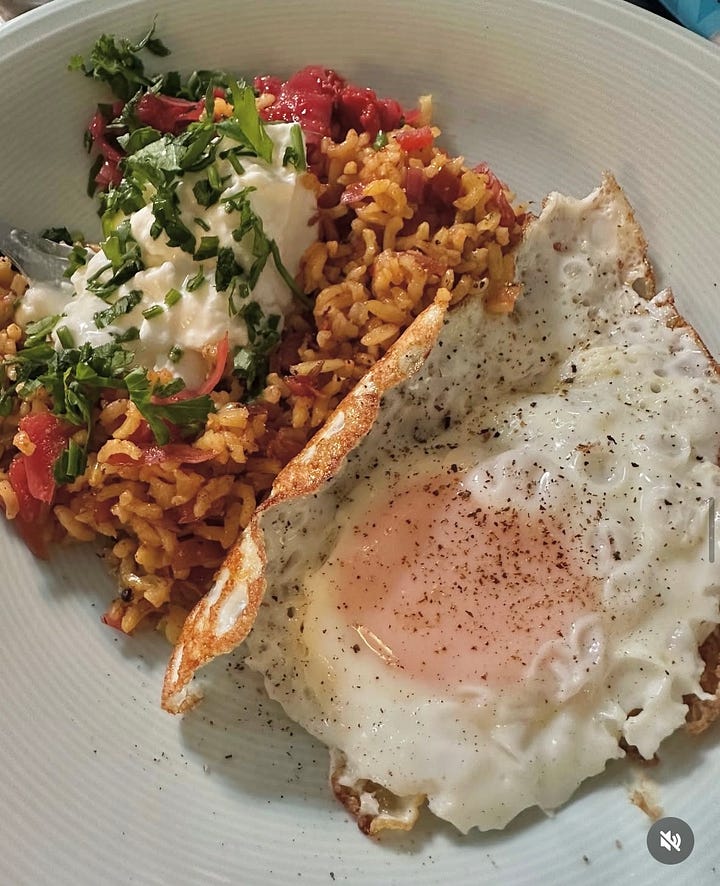
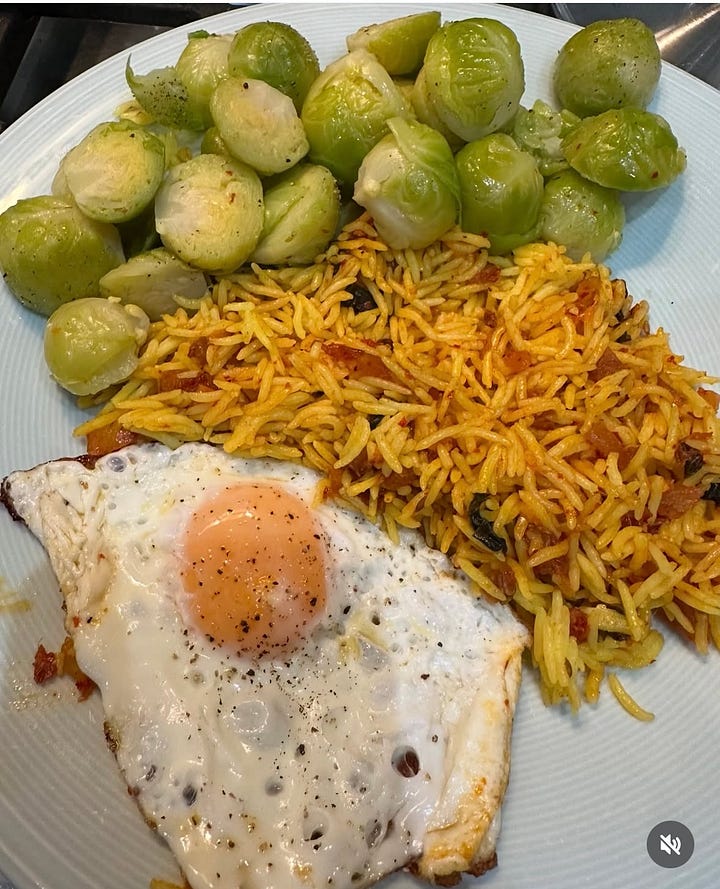
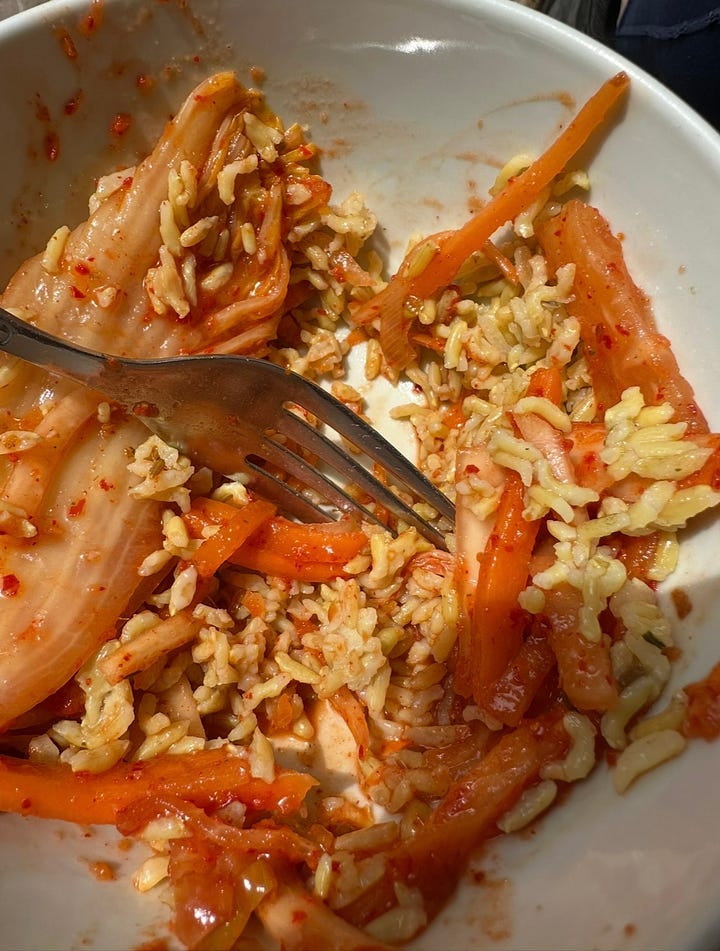
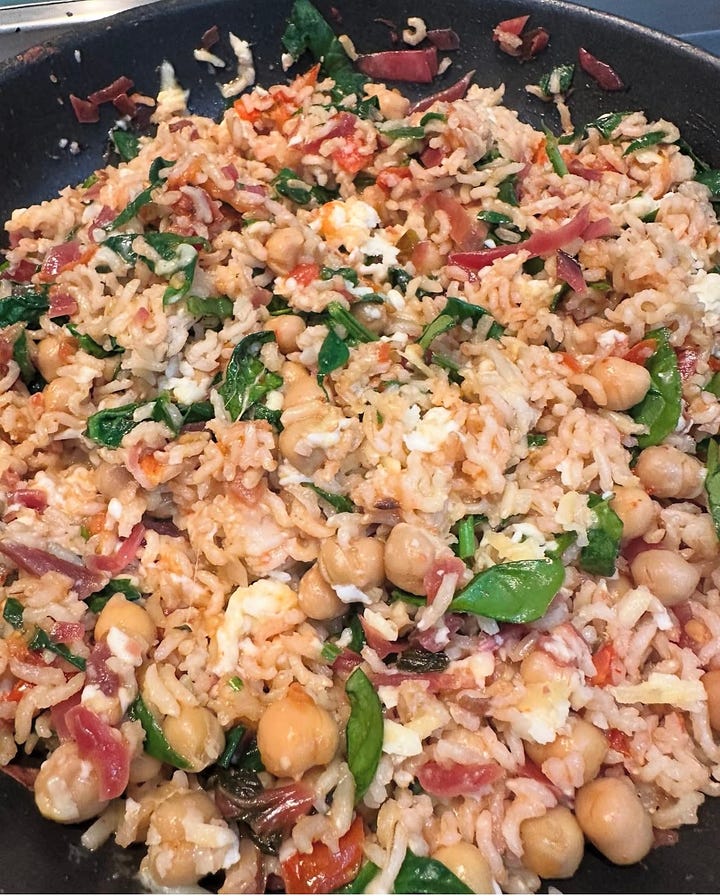
Method
You can make this in a stainless steel frying pan - let it heat till splashed water bounces merrily around the pan, then add the oil. Let that heat up and then add the oil. * (*don’t use a cast iron pan for this, as it’s acidic it will un-season it!)
When the oil is hot, set the pan to a medium heat, add the kimchi and let it fry for 3 or 4 minutes, till warmed through and the smell has changed - it will begin to smell as though it’s cooking
Add the rice, and pulses if using, and stir through.
If it’s very dry, add about 50ml water, just to keep it all moving.
heat through, add in your cheese if you want it to melt.
Fry your egg - sunny side up of course! (I always cover mine so the top turns opaque and there is no vestige of uncooked white, whilst retaining a runny yolk).
Assemble in a dish - top the kimchi rice with any toppings you’re using, then balance delicately the egg on top, or place jauntily on the side - seasoned appropriately!
The Rice
Most recipes recommend using cold rice, as freshly cooked hot or warm rice goes to mush quite easily in the pan. I would recommend reheating cold rice for an additional reason; when rice is cooked, (responsibly) cooled and reheated, the structure of the rice starch is altered, making it harder for our bodies to break down. It’s known as resistant starch and becomes food for our gut microbes, and human studies have shown a lower glycaemic response than with freshly cooked rice. (REF 1) .
I pressure cook large batches - Camargue red rice is my current favourite), cool rapidly by running through with cold water in a sieve, then split into 250g aliquots which I freeze. You can cheat and use a Tilda sachet - I love the sticky rice ones, but be careful not to pick something with loads of additives in. Sometimes I use Pilau rice which sounds like it might be at the extreme end of mixing cultures; cumin, cardamom, cloves and cinnamon shouldn’t work here but they do!
You can also substitute or mix in pearl barley, spelt, couscous, quinoa, whatever you have to hand.
The Kimchi
This is a great way to use up older or softer kimchi, as a more acidic flavour and softer texture will be advantages when the dish is ready. That said, if you’ve only got fresh kimchi don’t let that stop you!
The Extras
From the rnumber of optional ingredients you’ll have worked out that this can be as simple as kimchi and rice, or a multi-layered affair:
You can start by frying some bacon, pancetta or pork, or mushrooms before you add the kimchi.
I usually add a pulse of some sort because why not? Good for fibre and protein. Beluga lentils and chickpeas are my favourites.
I love to melt in some feta or other sharpish solid cheese but you can use whichever cheese takes your fancy - I’ve tried everything from a blob of Boursin to grated cheddar. If you don’t do dairy you can add some yeast flakes or cashew cheese.
I always have a tub of slow roasted tomatoes in the fridge - these are delicious additions, or if you’re craving a touch of tomato-iness, a tablespoon of tomato purée will do. - add with the rice, when you’ve fried off the kimchi
I always fry my egg but of course you can poach it or even stir it in with the rice if you like.
You could add extra garlic if you wanted, frying this to a lightly golden brown beforeu adding the kimchi.
References
Begum, Pathan S.; Madhavi, Gujjula1; Rajagopal, Senthilkumar2; Viswanath, Buddolla3; Razak, Meerza A.1; Venkataratnamma, Vanitha4,. Probiotics as Functional Foods: Potential Effects on Human Health and its Impact on Neurological Diseases. International Journal of Nutrition, Pharmacology, Neurological Diseases 7(2):p 23-33, Apr–Jun 2017. | DOI: 10.4103/ijnpnd.ijnpnd_90_16
Sonia S, Witjaksono F, Ridwan R. Effect of cooling of cooked white rice on resistant starch content and glycemic response. Asia Pac J Clin Nutr. 2015;24(4):620-5. doi: 10.6133/apjcn.2015.24.4.13. PMID: 26693746.




